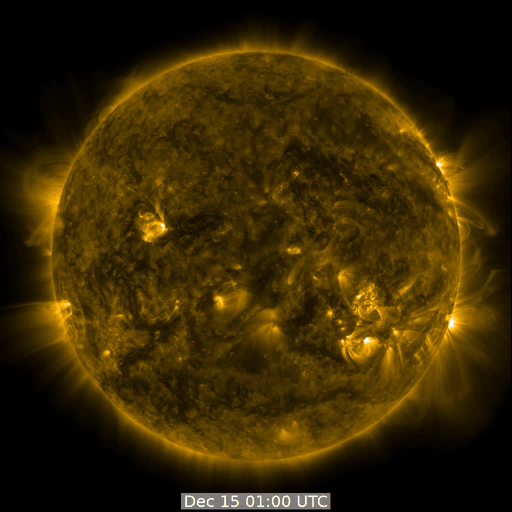Sun Images for Past 72 Hours

Images copyrighted by the SDO/NASA and Helioviewer project
📋 Propagation Summary
HF propagation today is being shaped by a moderate solar flux of 119 and a sunspot number of 68, but with a K-index at 4 indicating unsettled geomagnetic conditions. Expect generally fair conditions on the mid bands (20m, 17m, 15m), while lower bands (80m, 40m) are poor during the day but improve a bit at night. High bands (12m, 10m) are largely closed due to the combination of lower solar activity and elevated geomagnetic disturbance. Operators should anticipate some signal fading and increased noise, especially on polar and east-west paths. For best results, focus on the mid bands and take advantage of nighttime enhancements on 40m and 80m.
💡 Operator Tips
- Prioritize 20m, 17m, and 15m for daytime DX and reliable regional contacts.
- Use digital modes (FT8, FT4, PSK31) to punch through increased noise and fading.
- Low bands (80m, 40m) will be most productive after sunset; use narrow filters and low-noise antennas to combat static.
- With the K-index at 4, expect some auroral flutter and absorption, especially at higher latitudes—try southern or equatorial paths for better results.
- Contesters and DXers: Focus on grayline periods for enhanced propagation, especially on 20m and 40m.
- Keep an eye on real-time spots and cluster reports for sudden band openings.
⏰ Best Operating Times
- 80m & 40m: Best after local sunset through sunrise; avoid daytime.
- 20m: Good from late morning through early evening; check for grayline DX at sunrise/sunset.
- 17m & 15m: Open late morning to mid-afternoon; conditions fair, but watch for short-lived openings.
- 12m & 10m: Mostly closed, but check around local noon for any brief openings, especially if K-index drops.
- VHF/UHF: Little to no enhancement expected; aurora may provide fleeting opportunities at high latitudes.
🌍 DX Opportunities
- Grayline paths (sunrise/sunset) on 20m and 40m offer the best shot at DX, especially toward the southern hemisphere.
- Polar and trans-auroral paths may be degraded due to elevated K-index and aurora activity.
- East-west paths (e.g., trans-Atlantic, trans-Pacific) on 17m and 15m may support short openings during midday.
- No major special propagation events expected; monitor for sudden auroral or sporadic E activity if geomagnetic conditions change.
📻 Band-by-Band Analysis
| Band | Morning | Day | Evening | Night |
|---|---|---|---|---|
| 80m | 🟠 Fair | 🔴 Poor | 🟠 Fair | 🟠 Fair |
| 40m | 🟠 Fair | 🔴 Poor | 🟠 Fair | 🟠 Fair |
| 20m | 🟡 Good | 🟡 Good | 🟠 Fair | 🟠 Fair |
| 17m | 🟠 Fair | 🟠 Fair | 🟠 Fair | 🟠 Fair |
| 15m | 🟠 Fair | 🟠 Fair | 🟠 Fair | 🟠 Fair |
| 12m | 🔴 Poor | 🔴 Poor | 🔴 Poor | 🔴 Poor |
| 10m | 🔴 Poor | 🔴 Poor | 🔴 Poor | 🔴 Poor |
The 20m band is currently the most reliable for both local and DX contacts, especially during daylight hours. 17m and 15m are usable but less consistent, with short-lived openings possible. 80m and 40m are poor during the day but improve to fair at night, making them good choices for late evening and early morning work. 12m and 10m are mostly closed due to low solar flux and high geomagnetic activity—only check these bands if you see cluster spots or sudden drops in the K-index.
📊 Current Solar Activity
Solar Activity Metrics
K-index
Solar Flux (10.7cm)
Sunspot Number
- K-index: 4 (Unsettled to active geomagnetic conditions; expect increased noise and absorption, especially on polar paths)
- Solar Flux (10.7cm): 119 (Moderate; supports fair propagation on mid bands, but not enough for consistent high-band openings)
- Sunspot Number: 68 (Below recent averages; limits high-band propagation)
- Space Weather Overview: X-ray flux at B7.5 (quiet), solar wind speed elevated at 650 km/s (can drive geomagnetic activity), aurora index at 8 (possible auroral effects at high latitudes)
📈 Geomagnetic Conditions
Over the past 24 hours, the K-index has trended upward, moving from quiet (K=2-3) to unsettled/active (K=4) as of the latest reading. This increase is likely due to elevated solar wind speeds and can cause more absorption and fading, especially on high-latitude and polar paths. If the K-index continues to rise, expect further degradation on the higher HF bands and possible auroral activity on VHF.
🌟 Space Weather Details
Space Weather Dashboard
X-ray Activity
Solar Wind Speed
Aurora Activity
- X-ray Activity: B7.5 (low; no risk of HF blackouts from solar flares)
- Solar Wind: 650 km/s (high; can trigger geomagnetic disturbances and aurora, especially if the magnetic field turns southward)
- Particle Environment: Electron and proton flux not reported, but no major storming indicated; minimal impact on HF absorption
- Aurora Activity: 8 (moderate; VHF auroral propagation possible for northern operators, especially during local night)
- Helium Line: 125.4 (steady; no major upward or downward trend, suggesting stable but moderate solar activity)
📡 Propagation Timeline & Technical Details
Propagation Quality Timeline (24 Hours)
Recent months show a decline in both solar flux and sunspot numbers from their peaks in mid-2025. This trend is reflected in current band conditions, with fewer high-band openings and more reliance on mid and low bands for reliable contacts. The elevated K-index today is a temporary setback, but overall solar activity remains supportive of fair HF propagation on 20m and below.
Solar Activity Trends (6 Months)
🔮 3-Day Forecast